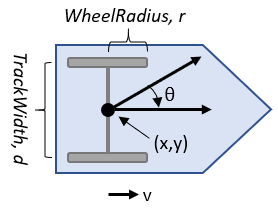differentialDriveKinematics
Modelo de vehículo con tracción diferencial
Descripción
differentialDriveKinematics crea un modelo de vehículo con tracción diferencial para simular dinámicas de vehículos simplificadas. Este modelo se aproxima a un vehículo con un solo eje fijo y ruedas separadas por un ancho de vía especificado. Las ruedas se pueden dirigir de forma independiente. La velocidad y la dirección del vehículo se definen desde el centro del eje. El estado del vehículo se define como un vector de tres elementos, [x y theta], con la posición global xy especificada en metros, y la dirección del vehículo, theta, especificado en radianes. Para calcular los estados de las derivadas de tiempo del modelo, use la función derivative con comandos de entrada y el estado actual del robot.

Creación
Sintaxis
Descripción
kinematicModel = differentialDriveKinematics
kinematicModel = differentialDriveKinematics(Name,Value)
Propiedades
Funciones del objeto
derivative | Derivada de tiempo del estado del vehículo |
Ejemplos
Referencias
[1] Lynch, Kevin M., and Frank C. Park. Modern Robotics: Mechanics, Planning, and Control 1st ed. Cambridge, MA: Cambridge University Press, 2017.
